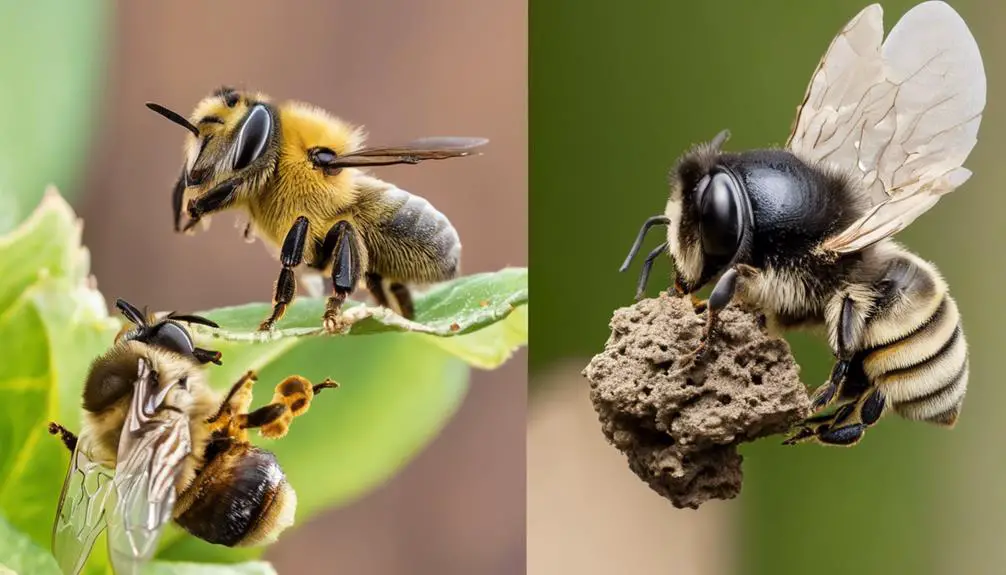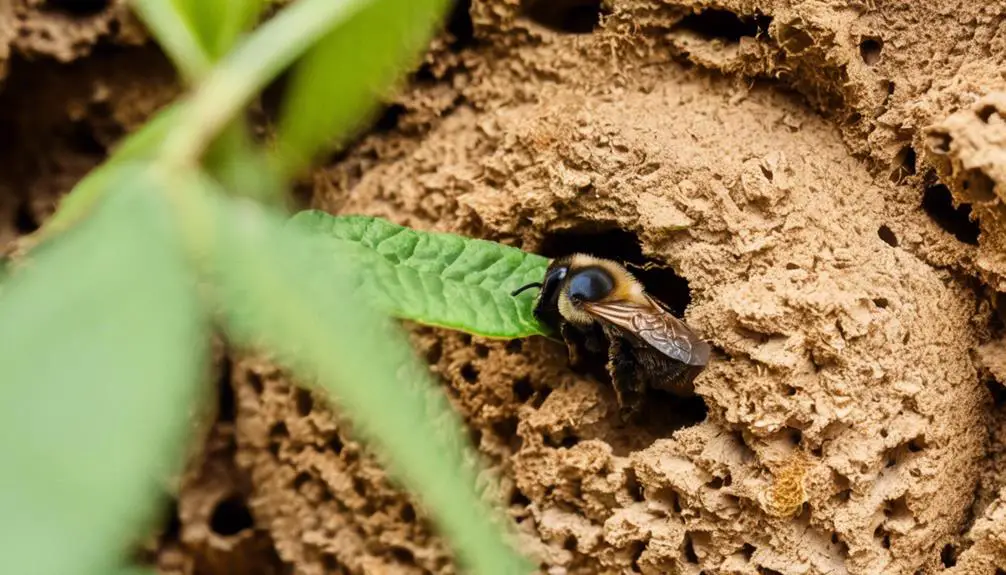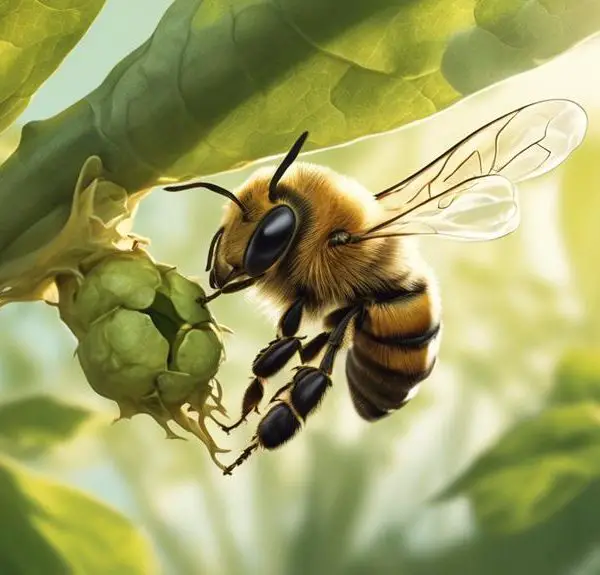Take a fascinating journey to distinguish between Leaf Cutter and Mason bees and their unique roles in our ecosystem.

Are Leaf Cutter Bees the Same as Mason Bees
Like two peas in a pod, Leaf Cutter and Mason bees may appear at first glance to be one and the same. However, as you dive deeper into the world of these fascinating insects, you'll find they are as distinct as they are similar.
You've probably seen them buzzing about, but do you really know the unique characteristics that set them apart? Are their roles in the ecosystem identical, or do they each contribute in their own unique way?
Let's embark on an intriguing journey, uncovering the mystery that surrounds these two bee species.
Key Takeaways
- Leaf Cutter Bees and Mason Bees belong to different families and have unique characteristics and nesting habits.
- Both bees are non-aggressive and rarely sting.
- Leaf Cutter Bees are valued for their ecological contributions and maintenance of biodiversity.
- Mason Bees are exceptional pollinators, especially for early blooming plants, and can do the pollination work of over 100 honeybees.
Understanding Leaf Cutter Bees

Diving into the world of Leaf Cutter Bees, you'll find these incredible insects aren't only fascinating but also hold a crucial role in our ecosystem. Unlike Mason Bees, Leaf Cutter Bees are solitary insects known for their distinct behavior of cutting circular pieces from leaves, which they use to build their nests.
These bees belong to the Megachilidae family, which includes over 1,500 species worldwide. They're known for their unique, scissor-like mandibles and their distinctively fuzzy bellies. You'd often spot these bees in gardens, diligently working on plants and flowers. Notably, they're crucial pollinators, aiding in the growth and reproduction of various plant species.
Leaf Cutter Bees have a relatively short lifespan, typically ranging from 2-3 months. Unlike other bees, they don't produce honey but are still valued for their ecological contributions. They're non-aggressive and rarely sting unless provoked.
Learning about Leaf Cutter Bees, you'll understand their importance in maintaining biodiversity, and why they're considered a gardener's friend. As you delve deeper, you'll appreciate their unique life cycle, mating rituals, and their coexistence with other bee species.
Delving Into Mason Bees

While Leaf Cutter Bees hold their own unique importance in our ecosystem, there's another equally intriguing species that demands our attention – the Mason Bees. Unlike their leaf-cutting counterparts, Mason Bees belong to the Osmia genus. They're named for their unique nesting habits, using mud or other 'masonry' materials to construct their homes.
You'd find these solitary creatures in hollow reeds or holes in wood made by other insects. They're non-aggressive and rarely sting unless threatened. Unlike honeybees, Mason Bees don't live in colonies, each female is fertile and makes her own nest.
Now, let's delve into their ecological significance. Mason Bees are exceptional pollinators. In fact, they're among the first bees to fly in the spring, making them vital for early blooming plants. They've a particular affinity for fruit trees, and a single Mason Bee can do the pollination work of over 100 honeybees. This makes them invaluable allies for orchard owners and gardeners.
Comparing Physical Characteristics

When you closely observe the Leaf Cutter and Mason Bees, you'll notice marked differences in their physical characteristics that go beyond their unique nesting habits. Leaf Cutter Bees, or Megachile, have robust bodies with stout jaws perfect for leaf cutting. They sport a metallic, blackish-blue body, typically around 10mm in size. Their most distinctive feature is their underbelly, equipped with a hairy 'pollen basket' for carrying pollen.
On the other hand, Mason Bees, also known as Osmia, depict a more delicate physique. They possess a metallic green or blue sheen, with a size range of 6-14mm. Unlike their Leaf Cutter counterparts, Mason Bees carry pollen on the scopa located on their hind legs.
The difference in their size, color, and pollen-carrying mechanism provides a clear distinction between the two. While they may share the same family, Megachilidae, their physical traits are as diverse as their behaviors. Their unique characteristics equip them differently for their roles in nature, whether it's cutting and carrying leaves or building nests with mud and masonry.
With these differences in mind, you can see how these two bee species are brilliantly designed for their respective lifestyles.
Habitat and Nesting Differences

You'll find stark contrasts in the habitats and nesting behaviors of Leaf Cutter and Mason Bees, each designed to support their unique lifestyle and ecological role. Leaf Cutter Bees, for instance, prefer to nest in soft, rotting wood or thick-stemmed plants, using their mandibles to cut out leaf sections to line their nests.
On the other hand, Mason Bees have a knack for taking advantage of existing spaces such as hollow stems or holes in wood, filling them with mud to create secure nests. They've even been known to make use of man-made structures!
The following table illustrates these differences:
Leaf Cutter Bees | Mason Bees | |
|---|---|---|
Habitat | Soft, rotting wood or thick-stemmed plants | Existing spaces such as hollow stems or holes in wood |
Nesting Material | Leaf sections | Mud |
In essence, their diversely adapted habitats and nesting behaviours contribute significantly to their survival and propagation, each bee species exploiting the resources available in their environment in unique ways. It's clear that while they may share the 'bee' moniker, Leaf Cutter and Mason Bees are distinctively different in their lifestyles.
Role in Pollination and Ecosystem

Despite their differences in habitat and nesting, both Leaf Cutter and Mason Bees play pivotal roles in pollination and the sustainability of our ecosystems. These industrious insects work tirelessly to transfer pollen from male to female plant parts, fostering seed and fruit production.
Leaf Cutter Bees, known for their solitary behavior, are efficient pollinators. They carry pollen on their abdomens and inadvertently distribute it while foraging. Their unique method of 'buzz pollination' ensures a higher yield of fruits and seeds, contributing significantly to the biodiversity of our planet.
Mason Bees, on the other hand, are renowned for their early spring activities. They emerge when temperatures rise, often before other pollinator species, thus playing a crucial role in the pollination of early-blooming plants. Their hairy bodies are designed to catch and distribute pollen, enhancing the reproduction of many plant species.
Conclusion
So, you see, leaf cutter and mason bees aren't the same. They've distinct physical characteristics, differing habitats and nesting behaviors.
Both are vital pollinators, but they play unique roles in our ecosystem. Understanding these subtle differences helps us better appreciate the diversity of bees and their importance to our environment.
Isn't it fascinating how such small creatures can have such a significant impact on our world? Let's continue cherishing and protecting these invaluable little pollinators.



